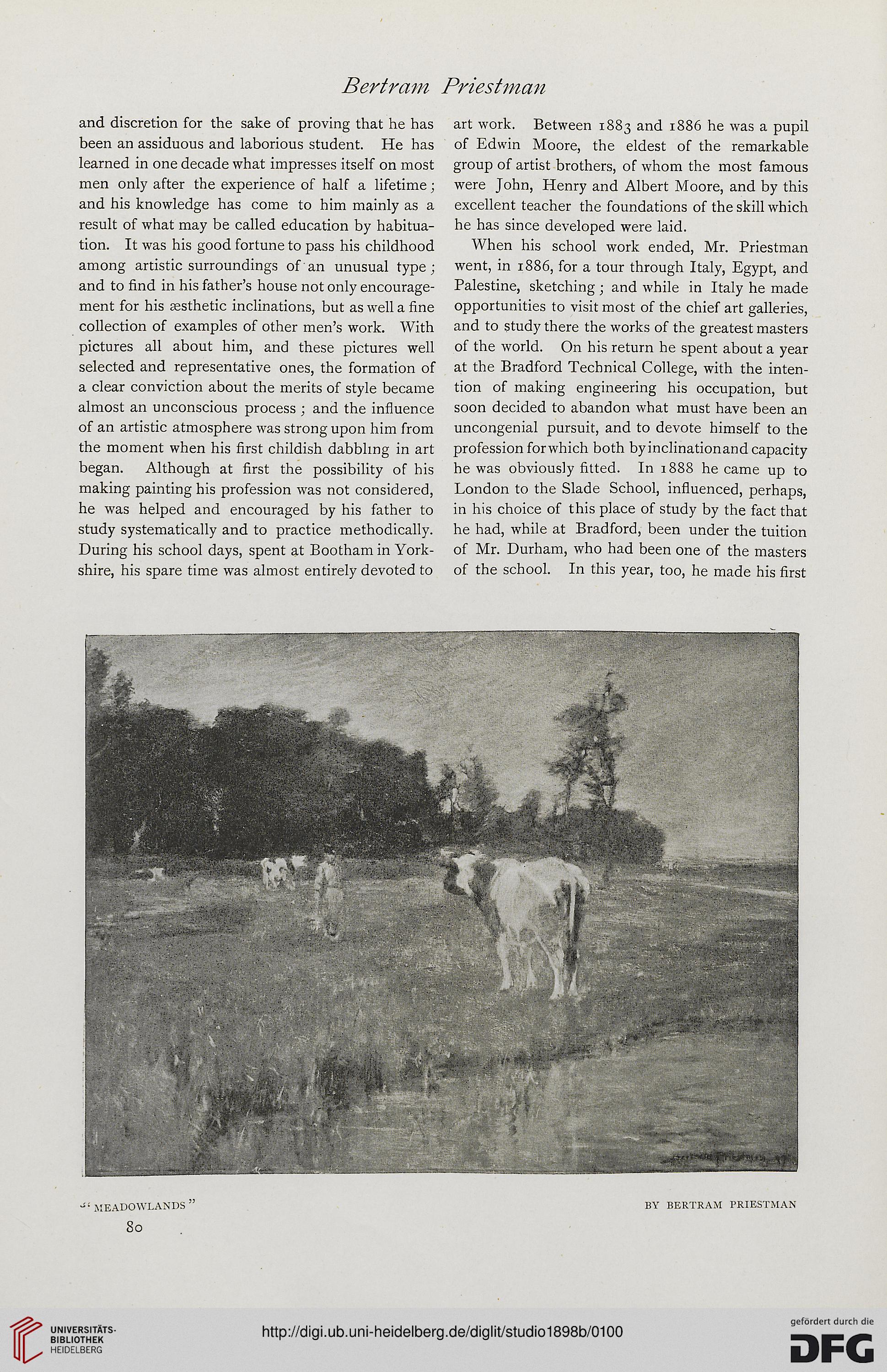Bertram Priestman
and discretion for the sake of proving that he has
been an assiduous and laborious student. He has
learned in one decade what impresses itself on most
men only after the experience of half a lifetime;
and his knowledge has come to him mainly as a
result of what may be called education by habitua-
tion. It was his good fortune to pass his childhood
among artistic surroundings of an unusual type ;
and to find in his father’s house not only encourage-
ment for his aesthetic inclinations, but as well a fine
collection of examples of other men’s work. With
pictures all about him, and these pictures well
selected and representative ones, the formation of
a clear conviction about the merits of style became
almost an unconscious process ; and the influence
of an artistic atmosphere was strong upon him from
the moment when his first childish dabbling in art
began. Although at first the possibility of his
making painting his profession was not considered,
he was helped and encouraged by his father to
study systematically and to practice methodically.
During his school days, spent at Boothamin York-
shire, his spare time was almost entirely devoted to
art work. Between 1883 and 1886 he was a pupil
of Edwin Moore, the eldest of the remarkable
group of artist brothers, of whom the most famous
were John, Henry and Albert Moore, and by this
excellent teacher the foundations of the skill which
he has since developed were laid.
When his school work ended, Mr. Priestman
went, in 1886, for a tour through Italy, Egypt, and
Palestine, sketching; and while in Italy he made
opportunities to visit most of the chief art galleries,
and to study there the works of the greatest masters
of the world. On his return he spent about a year
at the Bradford Technical College, with the inten-
tion of making engineering his occupation, but
soon decided to abandon what must have been an
uncongenial pursuit, and to devote himself to the
profession forwhich both by inclinationand capacity
he was obviously fitted. In 1888 he came up to
London to the Slade School, influenced, perhaps,
in his choice of this place of study by the fact that
he had, while at Bradford, been under the tuition
of Mr. Durham, who had been one of the masters
of the school. In this year, too, he made his first
and discretion for the sake of proving that he has
been an assiduous and laborious student. He has
learned in one decade what impresses itself on most
men only after the experience of half a lifetime;
and his knowledge has come to him mainly as a
result of what may be called education by habitua-
tion. It was his good fortune to pass his childhood
among artistic surroundings of an unusual type ;
and to find in his father’s house not only encourage-
ment for his aesthetic inclinations, but as well a fine
collection of examples of other men’s work. With
pictures all about him, and these pictures well
selected and representative ones, the formation of
a clear conviction about the merits of style became
almost an unconscious process ; and the influence
of an artistic atmosphere was strong upon him from
the moment when his first childish dabbling in art
began. Although at first the possibility of his
making painting his profession was not considered,
he was helped and encouraged by his father to
study systematically and to practice methodically.
During his school days, spent at Boothamin York-
shire, his spare time was almost entirely devoted to
art work. Between 1883 and 1886 he was a pupil
of Edwin Moore, the eldest of the remarkable
group of artist brothers, of whom the most famous
were John, Henry and Albert Moore, and by this
excellent teacher the foundations of the skill which
he has since developed were laid.
When his school work ended, Mr. Priestman
went, in 1886, for a tour through Italy, Egypt, and
Palestine, sketching; and while in Italy he made
opportunities to visit most of the chief art galleries,
and to study there the works of the greatest masters
of the world. On his return he spent about a year
at the Bradford Technical College, with the inten-
tion of making engineering his occupation, but
soon decided to abandon what must have been an
uncongenial pursuit, and to devote himself to the
profession forwhich both by inclinationand capacity
he was obviously fitted. In 1888 he came up to
London to the Slade School, influenced, perhaps,
in his choice of this place of study by the fact that
he had, while at Bradford, been under the tuition
of Mr. Durham, who had been one of the masters
of the school. In this year, too, he made his first




